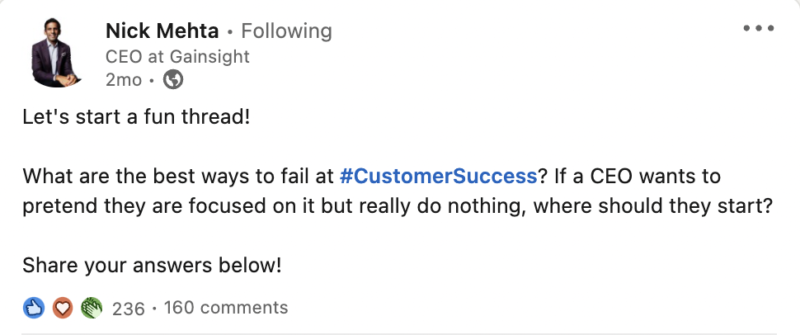SaaS is on fire. We all know that, but it strikes me every day. It used to be that you couldn’t name a SaaS company that I didn’t know. Now, I hear about ten new ones a day that I’ve never heard of. And companies and investors have realized that Net Retention – keeping and growing your existing clients – is the number one driver of shareholder value in SaaS businesses.

Because of this, 100% of SaaS companies are investing in Customer Success. To be honest, you’d look like a “poser” SaaS company if you aren’t focused on your clients. But the reality is that not every CEO is actually doing Customer Success well:

One of the biggest questions on the minds of CEOs is “how should I structure Customer Success?” This is quickly followed by questions like “where should it report?” and “what should it be responsible for?” But the logical next step is when CEOs ask me, “should I have a Chief Customer Officer?”
My short answer to that last question is always yes*. And here’s why:
- Customer Success Is a Company-Wide Strategy, Not Just a Function
The first mistake in Customer Success is not investing in a team. The second mistake is hiring a team of Customer Success Managers and calling it a day. Every sophisticated SaaS company realizes that Customer Success is about the entire customer journey – from Product Development to Marketing to Sales to Onboarding to Support to Customer Success to Renewals and Expansion.
To make this happen, you need an executive thinking about the customer journey. At a minimum, they should own all of the parts of the journey after the initial sale – e.g., Professional Services/Onboarding, Support, Adoption, Training, etc. And maybe they should own more (see the end of this post.)
- Since It’s a Company-Wide Strategy, a CCO Sends a Signal to the Company
You undoubtedly will have a Chief Financial Officer – because money is important. Same with having a Chief Product Officer – because tech is important. Sales are critical, so you have a Chief Sales or Revenue Officer. And you care about people; hence you have a Chief People Officer.
But what about your customers? Your employees are watching the signals you send in the structure of your executive team. Make sure Customer Success is more than just empty words.
- You Need a Customer Voice in the Executive Team and Board Room
It’s not just a signal. The people in your executive and board meetings define the content and agenda. You undoubtedly have powerful voices representing your other stakeholders. So who is there to represent your customers?
Who asks the hard questions about the upcoming product release and customer readiness? Who pushes hard to make sure the new clients coming in are set up for success? Who is in the core budgeting meetings when resources are divided up? Who is representing your clients to your Board in a data-driven manner?
- You Need a Peer to Your Sales and Product Leaders
One aspect of your Chief Customer Officer having “a seat at the table” is creating a power structure that allows them to be seen as peers with the other two of the three “Musketeers” of company-wide Customer Success – Sales and Product. The most successful organizations have strong relationships between all of these functions.
- You May Need a CCO Title to Get a Great Leader
The Customer Success job market is on fire. It’s absolutely nuts. So the best leaders are demanding the CCO title.
*Why Did I Say (Nearly)?
One of the other questions I get frequently is “should Customer Success report to Sales?” If your Sales leader is more of a classical (think “Glengarry Glen Ross”) sales executive, the answer is easy – absolutely not!
But if you have a President or COO who will put a Customer Success and Sales leader as peers underneath them, with equal focus on each, then that structure is fine. But don’t bury Customer Success under someone who doesn’t care. If you do that, just admit that you’re not a SaaS company.
What Should Go Under the Chief Customer Officer?
As I shared on LinkedIn recently, CCOs come in all flavors. Here’s a spectrum that I’ve seen:
- CCO-in-Name-Only: Only have Customer Success Managers under them.
- CCO Lite: CSM plus a few post-sales functions (e.g., Support or PS.)
- CCO: All post-sales functions (CSM, Support, Professional Services, Training.)Revenue CCO: CCO with commercial ownership of renewals (always better to own a number.)
- End-to-end CCO: CCO with pre-sales/sales engineering.
Over time, CCO roles are migrating further down that continuum to broader responsibilities.
And many CCOs have these ancillary functions under them:
- CS Operations: CSOps is a must; great if they can own it directly; if not, make sure RevOps/BizOps gives them DEDICATED resources.
- Customer Marketing: Eternal debate; for the adoption/1-to-many part of CM (digital CS / tech touch), it should be under CCO; for the advocacy part, under CMO unless CMO doesn’t prioritize it.
- Expansion: Not typically under CCO but in higher volume / transactional businesses, it’s becoming more common.
- Customer Experience: Can be part of CS Ops but worth someone owning end-to-end CX initiatives.
In Conclusion, Just Do It

While every company is different, I can almost guarantee that your clients are getting more power over you every year. Your competition is going up. Your business is getting less sticky. Your product is evolving.
If you care about Customer Success, put your titles where your mouth is and hire a Chief Customer Officer.

